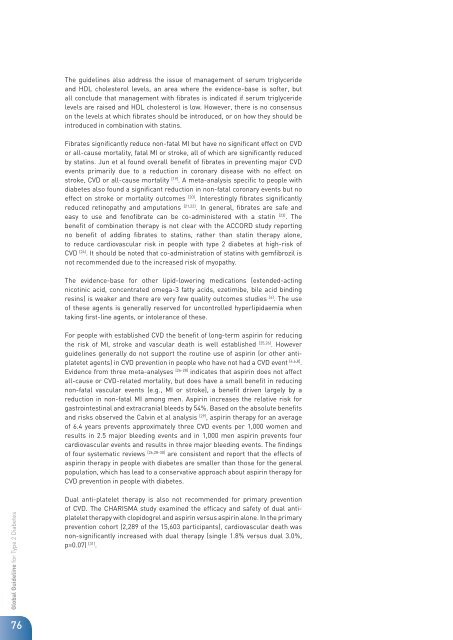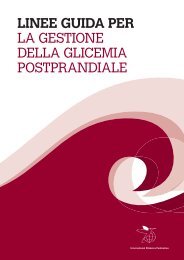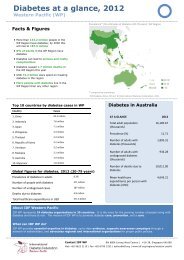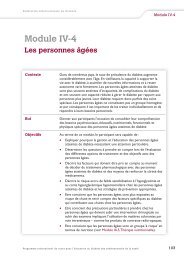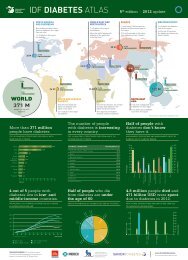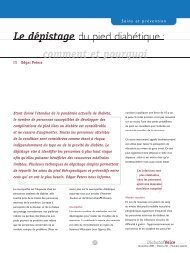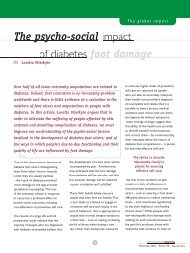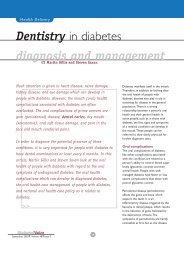Evidence-base - International Diabetes Federation
Evidence-base - International Diabetes Federation
Evidence-base - International Diabetes Federation
Create successful ePaper yourself
Turn your PDF publications into a flip-book with our unique Google optimized e-Paper software.
Global Guideline for Type 2 <strong>Diabetes</strong><br />
76<br />
The guidelines also address the issue of management of serum triglyceride<br />
and HDL cholesterol levels, an area where the evidence-<strong>base</strong> is softer, but<br />
all conclude that management with fibrates is indicated if serum triglyceride<br />
levels are raised and HDL cholesterol is low. However, there is no consensus<br />
on the levels at which fibrates should be introduced, or on how they should be<br />
introduced in combination with statins.<br />
Fibrates significantly reduce non-fatal MI but have no significant effect on CVD<br />
or all-cause mortality, fatal MI or stroke, all of which are significantly reduced<br />
by statins. Jun et al found overall benefit of fibrates in preventing major CVD<br />
events primarily due to a reduction in coronary disease with no effect on<br />
stroke, CVD or all-cause mortality [19] . A meta-analysis specific to people with<br />
diabetes also found a significant reduction in non-fatal coronary events but no<br />
effect on stroke or mortality outcomes [20] . Interestingly fibrates significantly<br />
reduced retinopathy and amputations [21,22] . In general, fibrates are safe and<br />
easy to use and fenofibrate can be co-administered with a statin [23] . The<br />
benefit of combination therapy is not clear with the ACCORD study reporting<br />
no benefit of adding fibrates to statins, rather than statin therapy alone,<br />
to reduce cardiovascular risk in people with type 2 diabetes at high-risk of<br />
CVD [24] . It should be noted that co-administration of statins with gemfibrozil is<br />
not recommended due to the increased risk of myopathy.<br />
The evidence-<strong>base</strong> for other lipid-lowering medications (extended-acting<br />
nicotinic acid, concentrated omega-3 fatty acids, ezetimibe, bile acid binding<br />
resins) is weaker and there are very few quality outcomes studies [6] . The use<br />
of these agents is generally reserved for uncontrolled hyperlipidaemia when<br />
taking first-line agents, or intolerance of these.<br />
For people with established CVD the benefit of long-term aspirin for reducing<br />
the risk of MI, stroke and vascular death is well established [25,26] . However<br />
guidelines generally do not support the routine use of aspirin (or other antiplatetet<br />
agents) in CVD prevention in people who have not had a CVD event [4,6,8] .<br />
<strong>Evidence</strong> from three meta-analyses [26-28] indicates that aspirin does not affect<br />
all-cause or CVD-related mortality, but does have a small benefit in reducing<br />
non-fatal vascular events (e.g., MI or stroke), a benefit driven largely by a<br />
reduction in non-fatal MI among men. Aspirin increases the relative risk for<br />
gastrointestinal and extracranial bleeds by 54%. Based on the absolute benefits<br />
and risks observed the Calvin et al analysis [29] , aspirin therapy for an average<br />
of 6.4 years prevents approximately three CVD events per 1,000 women and<br />
results in 2.5 major bleeding events and in 1,000 men aspirin prevents four<br />
cardiovascular events and results in three major bleeding events. The findings<br />
of four systematic reviews [26,28-30] are consistent and report that the effects of<br />
aspirin therapy in people with diabetes are smaller than those for the general<br />
population, which has lead to a conservative approach about aspirin therapy for<br />
CVD prevention in people with diabetes.<br />
Dual anti-platelet therapy is also not recommended for primary prevention<br />
of CVD. The CHARISMA study examined the efficacy and safety of dual antiplatelet<br />
therapy with clopidogrel and aspirin versus aspirin alone. In the primary<br />
prevention cohort (2,289 of the 15,603 participants), cardiovascular death was<br />
non-significantly increased with dual therapy (single 1.8% versus dual 3.0%,<br />
p=0.07) [31] .


